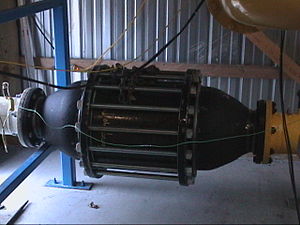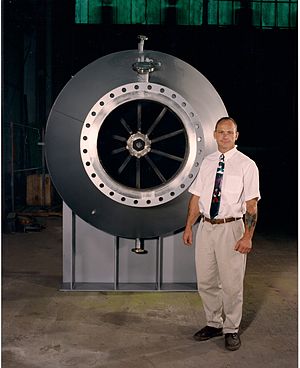- Flame arrester
-
A flame arrester (also spelled arrestor), deflagration arrester[1], or flame trap[2] is a device that stops fuel combustion by extinguishing the flame.[3].
Contents
Usage and applications
Flame arresters are used:
- to stop the spread of an open fire
- to limit the spread of an explosive event that has occurred
- to protect potentially explosive mixtures from igniting
- to confine fire within an enclosed, controlled, or regulated location
They are commonly used on:
- fuel storage tank vents
- fuel gas pipelines
- safety storage cabinets for paint, aerosol cans, and other flammable mixtures
- the exhaust system of internal combustion engines
- Davy lamps in coal mines
- overproof rum and other flammable liquors[2].
Principles
A flame arrester functions by forcing a flame front through channels too narrow to permit the continuance of a flame[2]. These passages can be regular, like wire mesh or a sheet metal plate with punched holes, or irregular, such as those in random packing[1].
The required size of the channels needed to stop the flame front can vary significantly, depending on the flammability of the fuel mixture. The large openings on a chain link fence are capable of stopping the spread of a small, slow-burning grass fire, but fast-burning grass fires will penetrate the fence unless the holes are very small[4]. In a coal mine containing highly explosive coal dust or methane, the wire mesh of a Davy lamp must be very tightly spaced.
For flame arresters used as a safety device, the mesh must be protected from damage due being dropped or struck by another object, and the mesh must be capable of rigidly retaining its shape during a forceful explosive event. Any shifting of the individual wires that make up the mesh can create an opening large enough to allow the flame to penetrate and spread beyond the barrier.
On a fuel storage vent, flame arresters also serve a secondary purpose of allowing air pressure to equalize inside the tank when fuel is added or removed, while also preventing insects from flying or crawling into the vent piping and fouling the fuel in the tanks and pipes.
Safety
Flame arresters should be used only in the conditions they have been designed and tested for. Since the depth on an arrester is specified for certain conditions, changes in the temperature, pressure, or composition of the gases entering the arrester can cause the flame spatial velocity to increase, making the depth of the arrester insufficient to stop the flame front. The deflagration may continue downstream of the arrester[1].
Flame arresters should be periodically inspected to make sure they are free of dirt, insects using it as a nest, or corrosion. The U.S. Chemical Safety and Hazard Investigation Board concluded that an uninspected and badly corroded flame arrester failed to prevent a 2006 explosion at a wastewater treatment plant in Daytona Beach, Florida[5].
References
- ^ a b c Arpentinier, Philippe; Cavani, Fabrizio; Trifiro, Ferrucio (2001). The Technology of Catalytic Oxidations. 2. Paris: Editions TECHNIP. pp. 748. ISBN 2710807777. http://books.google.com/?id=-XDi6aAJPl0C&pg=PA748&dq=Deflagration+and+Detonation+Flame+Arresters. Retrieved November 19, 2007
- ^ a b c McManus, Neil (1998). Safety and Health in Confined Spaces. CRC Press. pp. 147. ISBN 1566703263. http://books.google.com/?id=ygATMSwPbtAC&pg=RA2-PA147&dq=Deflagration+and+Detonation+Flame+Arresters. Retrieved November 19, 2007
- ^ The United States Chemical Safety and Hazard Investigation Board (2005). Investigation Report: Aluminum Dust Explosion, Hayes Lemmerz International-Huntington, Inc, Huntington, Indiana, October 29, 2003. The United States Chemical Safety and Hazard Investigation Board. pp. 47. Archived from the original on 2007-10-24. http://web.archive.org/web/20071024141429/http://www.csb.gov/completed_investigations/docs/HL+Publish+Final.pdf. Retrieved 2007-11-19.
- ^ Do Wire Fences Stop Ground Fires?, JAMES L. MURPHY AND HARRY E. SCHIMKE, U.S. Forest Service Research Note PSW-70, Pacific southwest forest and range experiment station, Berkeley, CA, 1965, http://www.fs.fed.us/psw/publications/documents/psw_rn070/psw_rn070.pdf
- ^ The United States Chemical Safety and Hazard Investigation Board (2007). Investigation Report: Methanol Tank Explosion and Fire, Bethune Point Wastewater Treatment Plant, City of Daytona Beach, Florida, January 11, 2006. The United States Chemical Safety and Hazard Investigation Board. pp. 29. http://www.csb.gov/assets/document/Bethune_Final_Report.pdf. Retrieved 2010-02-13.
See also
- Flashback arrestor
- Detonation arrester
Categories:- Chemical engineering
- Fire prevention
- Chemical safety
- Safety engineering
- Occupational safety and health
Wikimedia Foundation. 2010.


